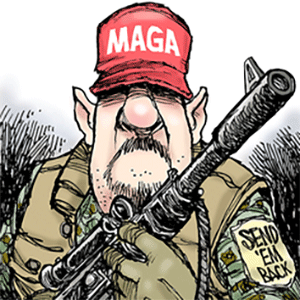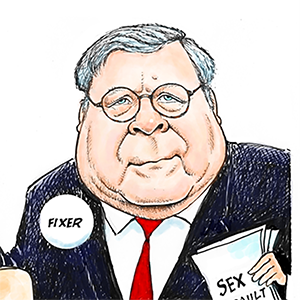Injunction ruling provides new look at 'Blitz,' from tear gas to agent using ChatGPT to help write report
Published in News & Features
CHICAGO — A federal judge on Thursday issued a scathing opinion that takes a deep dive into the use of force by immigration agents during “Operation Midway Blitz,” revealing new information gleaned from body-worn cameras and other evidence showing how agents used tear gas and flash bang grenades on fleeing protesters, shot praying ministers in the face with pepper balls, and even used ChatGPT to help write a report.
The 233-page written ruling by U.S. District Judge Sara Ellis memorializes her findings in issuing a preliminary injunction earlier this month.
Elllis’ injunction was stayed by the 7th Circuit U.S. Court of Appeals on Wednesday, which called it “overbroad” and said it improperly targets virtually the entire executive branch, including President Donald Trump.
In agreeing to issue a stay, however, the 7th Circuit warned to “not overread” the order, saying Ellis’ findings “may support entry of a more tailored and appropriate preliminary injunction” down the line.
Ellis was scheduled to hold a hearing on Thursday afternoon on next steps in the case, including how and when to make much of the evidence she used to make her decision — including hours of body camera footage, use-of-force reports, and depositions of some of the top leaders of Midway Blitz — publicly available.
In her ruling Thursday, Ellis said that Border Patrol Cmdr. Gregory Bovino, the tough-talking field general who was the face of the Trump administration’s operation, was “evasive” during his three days of sworn testimony with plaintiffs’ attorneys, “either providing ‘cute’ responses” or “outright lying.”
In one high-profile incident in Little Village where Bovino initially claimed he’d been hit in the head with a rock, Ellis wrote the only object that came near him was a tear gas canister that protesters threw back in the vicinity of agents.
Footage showed Bovino “rolled a second canister” of tear gas at people as they fled, Ellis said, as another agent near Bovino fired a flashbang grenade at the crowd.
Ellis also questioned Bovino’s testimony about seeing suspected Latin Kings gang members taking weapons out of the back of their car in Little Village and others on rooftops and in the crowd. Bovino testified the fact they were wearing “maroon hoodies … would signify a potential assailant or street gang member that was making their way to the location that I was present.”
But maroon is not the color of the Latin Kings, Ellis noted. What’s more, the footage from that day only showed a few people wearing maroon clothing — and one of them was Ald. Byron Sigcho-Lopez.
The testimony about “individuals in maroon hoodies being associated with the Latin Kings and threats strains credulity,” the judge said.
Meanwhile, Ellis’ ruling goes methodically through many of the more high-profile melees between immigration agents and protesters during the two-month operation, including incidents in Albany Park, Old Irving Park, Evanston and the Far East Side.
In Brighton Park on Oct. 4, where a crowd gathered after the shooting of Marimar Martinez, Ellis describes footage of agents shooting flash bang grenades at protesters, and one agent appearing to kick a protester who was on the ground as he walked away.
Ellis said that, over and over, body-worn camera footage from the agents undermined what the agents put in their use-of-force reports, rendering the reports unreliable.
In fact, Ellis said, one body-worn camera video captured an immigration agent using the AI tool ChatGPT to “compile a narrative for a report based off of a brief sentence about an encounter and several images.”
“To the extent that agents use ChatGPT to create their use of force reports, this further undermines their credibility and may explain the inaccuracy of these reports when viewed in light of the BWC footage,” Ellis wrote.
Ellis’ preliminary injunction, issued two weeks ago, prohibits immigration agents from deploying tear gas or other munitions before issuing two explicit warnings, requires agents in the field to have body cameras and wear clear identification on their uniforms and forbids law enforcement from targeting journalists or interrupting their news gathering in most circumstances.
Unlike a temporary restraining order Ellis issued on Oct. 9, the preliminary injunction was to remain in effect until a final decision on the merits of the case is made, either at trial or through a settlement.
Last week, Ellis set a trial on a permanent injunction for early March.
In asking the 7th Circuit for an emergency stay, lawyers for the U.S. Department of Justice wrote that the case was a “perfect example” of a growing trend in the nation’s courts to issue sweeping injunctions that violate the separation of powers and “superintend law-enforcement activities under threat of contempt.”
“The predictable result is to broadly obstruct the enforcement of the nation’s laws, chill the exercise of executive power, and subvert the constitutional structure,” the 22-page filing stated.
The filing also alleged the injunction is “unworkable in practice” and illegally transforms her into a “supervisory tribunal” for deciding whether federal officers were acting lawfully in their day-to-day operations.
In its order granting a stay, the 7th Circuit said the government was likely to succeed on those arguments.
“The preliminary injunction entered by the district court is overbroad,” the order said. “In no uncertain terms, the district court’s order enjoins an expansive range of defendants, including the President of the United States, the entire Departments of Homeland Security and Justice, and anyone acting in concert with them. … The practical effect is to enjoin all law enforcement officers within the Executive Branch.”
Ellis’ injunction also requires to submit all future guidelines for use of force to the court for review, “a mandate impermissibly infringing on principles of separation of powers on this record,” the appeals court said.
The injunction was also too “prescriptive” in barring the “use of scores of riot control weapons and other devices in a way that resembles a federal regulation,” the appellate court order said.
All three judges on the panel that issued the stay are Republican nominees. Judge Frank Easterbook was nominated by President Ronald Reagan, while Judge Michael Scudder and Judge Michael Brennan were each nominated by Trump in his first term.
Later Wednesday, the 7th Circuit issued an expedited appeal schedule, asking for the government’s brief no later than Nov. 26, and any reply by Dec. 3. Oral arguments could be set soon after.
____
©2025 Chicago Tribune. Visit at chicagotribune.com. Distributed by Tribune Content Agency, LLC.







Comments